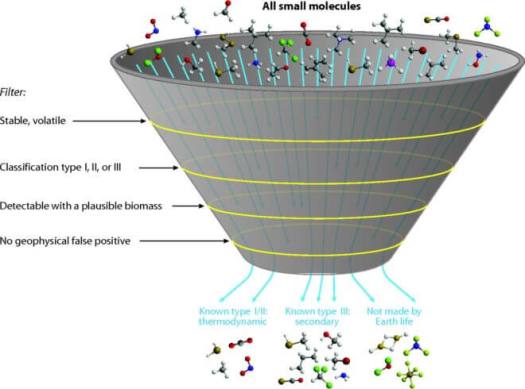
The search for life beyond our solar system has focused largely on the detection of an ever-increasing number of exoplanets, determinations of whether the planets are in a habitable zone, and what the atmospheres of those planets might look like. It is a sign of how far the field has progressed that scientists are now turning with renewed energy to the question of what might, and what might not, constitute a sign that a planet actually harbors life.
The field of “remote biosignatures” is still in its early stages, but a NASA-sponsored workshop underway in Seattle has brought together dozens of researchers from diverse fields to dig aggressively into the science and ultimately convey its conclusions back to the exoplanet community and then to the agency.
While a similar NASA-sponsored biosignatures workshop put together a report in 2002, much has changed since then in terms of understanding the substantial complexities and possibilities of the endeavor. There is also a new sense of urgency based on the observing capabilities of some of the space and ground telescopes scheduled to begin operations in the next decade, and the related need to know with greater specificity what to look for.
“The astrobiology community has been thinking a lot more about what it means to be a biosignature,” said Shawn Domogal-Goldman of the Goddard Space Flight Center, one of the conveners of the meeting. Some of the reason why is to give advice to those scientists and engineers putting together space telescope missions, but some is the pressing need to maintain scientific rigor for the good of one of humankind’s greatest challenges.
“We don’t want to spend 20 years of our lives and billions in taxpayer money working for a mission to find evidence of life, and learn too late that our colleagues don’t accept our conclusions,” he told me. “So we’re bringing them all together now so we can all learn from each other about what would be, and what would not be, a real biosignature.”

The three-day workshop is bringing together some 50 scientists ranging from astronomers, astrobiologists and planetary scientists to microbiologists and specialists in photosynthesis. Organized by NASA’s Nexus for Exoplanet System Science (NExSS) — an initiative created to encourage interdisciplinary collaboration — it has been tasked with putting together a report for the larger exoplanet community and ultimately for NASA.
The first day of the workshop featured a review of previous work on biosignatures, which initially put forward the presence of oxygen in an exoplanet atmosphere as a strong and almost certain sign that biology was at work below. This is because oxygen, which is a byproduct of much life, bonds quickly with other molecules and so would be undetectable unless it was continuously replenished.
But as outlined by Victoria Meadows, director of the Virtual Planet Laboratory at the University of Washington, more recent research has shown large amounts of oxygen can be produced without biology under a number of (usually extreme) conditions. There has been a resulting focus on potential false positive signals regarding oxygen and other molecules.
From another perspective, Tim Lyons, a biogeochemist from the University of California, Riverside, used the early and middle Earth as an example how easy it is to arrive at a false negative result.
He said that current thinking is that for as long as two billion years, Earth was inhabited but the lifeforms produced little oxygen. If analyzed from afar for all those years, the result would be a complete misreading of life on Earth.
With these kinds of false positives and negatives in mind, Meadows said that the current approach to understanding biosignatures is to look beyond a single molecule to the broader planetary and solar environment.
“We have to look not just at single biosignatures, but at their their context on the planet. How might life have modified an environment in a potentially detectable way? And having stepped back a bit, does the biosignature make sense?”
As one example, while oxygen alone is no longer considered a sure biosignature, oxygen in an atmosphere in the presence of methane would be convincing because of the known results of the chemical interactions of the two.

The goal is to start with chemistry and generate a list of all small molecules and filter them for the set that is stable and volatile in temperature and pressure conditions relevant for exoEarth planetary atmospheres. In the ideal situation, this overall conceptual process would lead to a finite but comprehensive list of molecules that could be considered in the search for exoplanet biosignature gases. (S. Seager and D. Beckner)
In part because of the false positive/false negative issues involving oxygen, some have begun a concerted effort to produce a list of additional possible biosignatures. William Bains, a member of Sara Seager’s team at the Massachusetts Institute of Technology, described the blunderbuss approach they have adopted: examining some 14,000 compounds simple (fewer than six non-hydrogen atoms) and stable enough to exist in the atmosphere of an exoplanet.
In their Astrobiology Journal article, Seager, Bains and colleagues wrote that “To maximize our chances of recognizing biosignature gases, we promote the concept that all stable and potentially volatile molecules should initially be considered as viable biosignature gases.”
Elaborating during the workshop, Bains asked: “Why does life produce the gases that it does? We really don’t know, so we’re bringing in everything as a possibility.” Not surprisingly, he said, “The more you search, the more you find.”
And as for the possibility of life existing in extreme environments, Bains referred to the microbes known to live in radioactive environments, in plastic, and virtually everywhere else on Earth.
Because the science of remote biosignatures is still in its early stages, what is known tends to overwhelm what is not known — making the whole endeavor sometimes seem near impossible. After all, it’s proven extremely difficult to determine whether there was ever life on “nearby” Mars, and scientists have Martian meteorites to study and rovers sending back information about the geology, the geochemistry, the weather, the atmospheric conditions and the composition of the planet.
By comparison, learning how to probe the atmospheres of faraway exoplanets and assess what might or might not be a biosignature will have to be done entirely with next generation space telescopes and the massive ground telescopes in development. The information in the photons they collect will tell scientists what compounds are present, whether liquid water is present on the surface, and potentially whether the surface is changing with seasons. And then the interpretation begins.
That’s why Mary Voytek, the originator of NExSS and the head of the NASA astrobiology program, said at the workshop that the goal was to test and ultimately provide as many biosignatures as possible.
She wants many molecules potentially associated with life to be identified and then studied and restudied in the same critical way that oxygen has been — embraced for the biosignature possibilities it offers, and understood for the false positives and false negatives that might mislead.
“What we need is an arsenal,” she said, as many ways to sniff out the byproducts of exoplanet life as that daunting task demands.
